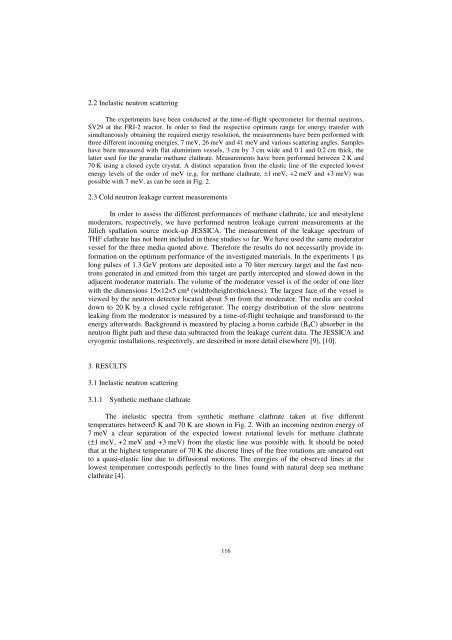Druck-Materie 20b.qxd - JUWEL - Forschungszentrum Jülich
Druck-Materie 20b.qxd - JUWEL - Forschungszentrum Jülich
Druck-Materie 20b.qxd - JUWEL - Forschungszentrum Jülich
Create successful ePaper yourself
Turn your PDF publications into a flip-book with our unique Google optimized e-Paper software.
2.2 Inelastic neutron scattering<br />
The experiments have been conducted at the time-of-flight spectrometer for thermal neutrons,<br />
SV29 at the FRJ-2 reactor. In order to find the respective optimum range for energy transfer with<br />
simultaneously obtaining the required energy resolution, the measurements have been performed with<br />
three different incoming energies, 7 meV, 26 meV and 41 meV and various scattering angles. Samples<br />
have been measured with flat aluminium vessels, 3 cm by 7 cm wide and 0.1 and 0.2 cm thick, the<br />
latter used for the granular methane clathrate. Measurements have been performed between 2 K and<br />
70 K using a closed cycle crystat. A distinct separation from the elastic line of the expected lowest<br />
energy levels of the order of meV (e.g. for methane clathrate, ±1 meV, +2 meV and +3 meV) was<br />
possible with 7 meV, as can be seen in Fig. 2.<br />
2.3 Cold neutron leakage current measurements<br />
In order to assess the different performances of methane clathrate, ice and mesitylene<br />
moderators, respectively, we have performed neutron leakage current measurements at the<br />
<strong>Jülich</strong> spallation source mock-up JESSICA. The measurement of the leakage spectrum of<br />
THF clathrate has not been included in these studies so far. We have used the same moderator<br />
vessel for the three media quoted above. Therefore the results do not necessarily provide information<br />
on the optimum performance of the investigated materials. In the experiments 1 µs<br />
long pulses of 1.3 GeV protons are deposited into a 70 liter mercury target and the fast neutrons<br />
generated in and emitted from this target are partly intercepted and slowed down in the<br />
adjacent moderator materials. The volume of the moderator vessel is of the order of one liter<br />
with the dimensions 15×12×5 cm³ (width×height×thickness). The largest face of the vessel is<br />
viewed by the neutron detector located about 5 m from the moderator. The media are cooled<br />
down to 20 K by a closed cycle refrigerator. The energy distribution of the slow neutrons<br />
leaking from the moderator is measured by a time-of-flight technique and transformed to the<br />
energy afterwards. Background is measured by placing a boron carbide (B4C) absorber in the<br />
neutron flight path and these data subtracted from the leakage current data. The JESSICA and<br />
cryogenic installations, respectively, are described in more detail elsewhere [9], [10].<br />
3. RESULTS<br />
3.1 Inelastic neutron scattering<br />
3.1.1 Synthetic methane clathrate<br />
The inelastic spectra from synthetic methane clathrate taken at five different<br />
temperatures between5 K and 70 K are shown in Fig. 2. With an incoming neutron energy of<br />
7 meV a clear separation of the expected lowest rotational levels for methane clathrate<br />
(±1 meV, +2 meV and +3 meV) from the elastic line was possible with. It should be noted<br />
that at the highest temperature of 70 K the discrete lines of the free rotations are smeared out<br />
to a quasi-elastic line due to diffusional motions. The energies of the observed lines at the<br />
lowest temperature corresponds perfectly to the lines found with natural deep sea methane<br />
clathrate [4].<br />
116

















